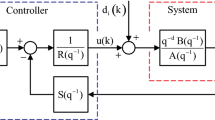Abstract
The simulated moving bed (SMB) process, after more than 40 years of successful operation in the petro-chemical industry, has emerged as one of the most important separation processes in the pharmaceutical, fine chemical, and biotechnology fields. However, optimal operation and automatic control of the SMB process is still challenging because of its complex dynamics caused by periodic port switching and inherent nonlinearity. In this research, a novel advanced control technique for the SMB process has been proposed. In the proposed technique, regulation of both extract and raffinate purities measured at the terminal time of each switching period is performed by a nonlinear repetitive controller which utilizes the past period data as feedback information. The repetitive controller was designed on the basis of a fundamental nonlinear model of the SMB process. Through application to a numerical SMB process, it was found that the proposed control technique performs quite satisfactorily against model error as well as set point and disturbance changes.
Similar content being viewed by others
References
Abel, S., Mazzotti, M., Erdem, G., Morari, M. and Morbidelli, M., “Optimizing Control of Simulated Moving Beds-Linear Isotherm”,J. Chromatogr. A,1033, 229 (2004).
Broughton, D. B., Neuzil, R. W., Pharis, J. M. and Brearley, C. S., “The Parex Process for Recovering Paraxylene”,Chem. Eng. Prog.,66, 70 (1970).
Erdem, G., Abel, S., Morari, M., Mazzotti, M., Morbidelli, M. and Lee, J. H., “Automatic Control of Simulated Moving Beds”,Ind. Eng. Chem.Res.,43, 405 (2004).
Grewel, M. and Andrews, A.,Kalman Filtering: Theory and Practice using MATLAB, 2nd ed., John Wiley and Sons, New York (2001).
Hara, S., Yamamoto, Y., Omata, T. and Nakano, N., “Repetitive Control System: A New Type Servo System for Periodic Exogeneous Signals”,IEEE Trans. A.C.,33, 659 (1988).
Johnson, J. A. and Kabza, R.G.,SORBEX: Industrial-Scale Adsorptive Separation, Preparative and Production Scale Chromatography. G. Ganetsos and P. E. Barker, eds., Dekker, New York (1993).
Juza, M., Mazzotti, M. and Morbidelli, M., “Simulated Moving Bed Chromatography and its Application to Chirotechnology”,Trends in Biotech.,18, 108 (2000).
Klatt, K., Hanisch, F., Dunnebier, G. and Engell, S., “Model-based Optimization and Control of Chromatographic Processes”,Comput. Chem. Eng.,24, 1119 (2000).
Klatt, K., Hanisch, F. and Dunnebier, G., “Model-based Control of a Simulated Moving Bed Chromatographic Process for the Separation of Fructose and Glucose”,Journal of Process Control.,12, 203 (2002).
Kloppenburg, E. and Gilles, E., “Automatic Control of the Simulated Moving Bed Process for C8 Aromatics Separation using Asymptotically Exact Input/output Linearization”,J. Process Control,9, 41 (1999).
Ledwich, G F. and Bolton, A., “Repetitive and Periodic Controller Design”,IEEE Proc. on Control Theory and Application-D,140, 19 (1993).
Lee, J. H., Lee, K. S. and Kim, W. C., “Model-based Iterative Learning Control with a Quadratic Criterion for Time-varying Linear Systems”,Automatica,36, 641 (2000).
Lee, J. H., Natarajan, S. and Lee, K. S., “A Model-based Predictive Control Approach to Repetitive Control of Continuous Processes with Periodic Operations”,J. Process Control,11, 195 (2001).
Lee, K. S. and Lee, J. H.,Model-based Predictive Control Combined with Iterative Learning for Batch or Repetitive Processes, In Iterative Learning Control, Chapter 16, 313, edited by Bien, Z., Xu, J., Kluwer Academic Publisher: Boston, (1998).
Lim, Y. I., “An Optimization Strategy for Nonlinear Simulated Moving Bed Chromatography: Multi-Level Optimization Procedure (MLOP)”,Korean J. Chem. Eng.,21, 836 (2004)
Ma, Z. and Guiochon, G., “Application of Orthogonal Collocation on Finite Elements in the Simulation of Non-linear Chromatography”,Comput. Chem. Eng.,15, 415 (1991).
Mazzotti, M., Storti, G. and Morbidelli, M., “Optimal Operation of Simulated Moving Bed Units for Nonlinear Chromatographic Separations”,J. Chromatogr. A,769, 3 (1997).
Morari, M. and Lee, J. H., “Model Predictive Control: Past, Present and Future”,Comput. Chem. Eng.,23(4), 667 (1999).
Natarajan, S. and Lee, J. H., “Repetitive Model Predictive Control Applied to a Simulated Moving Bed Chromatography System”,Comput. Chem. Eng.,24, 1127 (2000).
Pais, L. S., Loureiro, J. M. and Rodrigues, A. E., “Modeling Strategies for Enantiomers Separation by SMB Chromatography”,AIChE J.,44(3), 561 (1998).
Author information
Authors and Affiliations
Corresponding author
Rights and permissions
About this article
Cite this article
Kim, I.S., Lee, K.S. & Koo, YM. Nonlinear model-based repetitive control of simulated moving bed process. Korean J. Chem. Eng. 22, 830–838 (2005). https://doi.org/10.1007/BF02705661
Received:
Accepted:
Issue Date:
DOI: https://doi.org/10.1007/BF02705661




